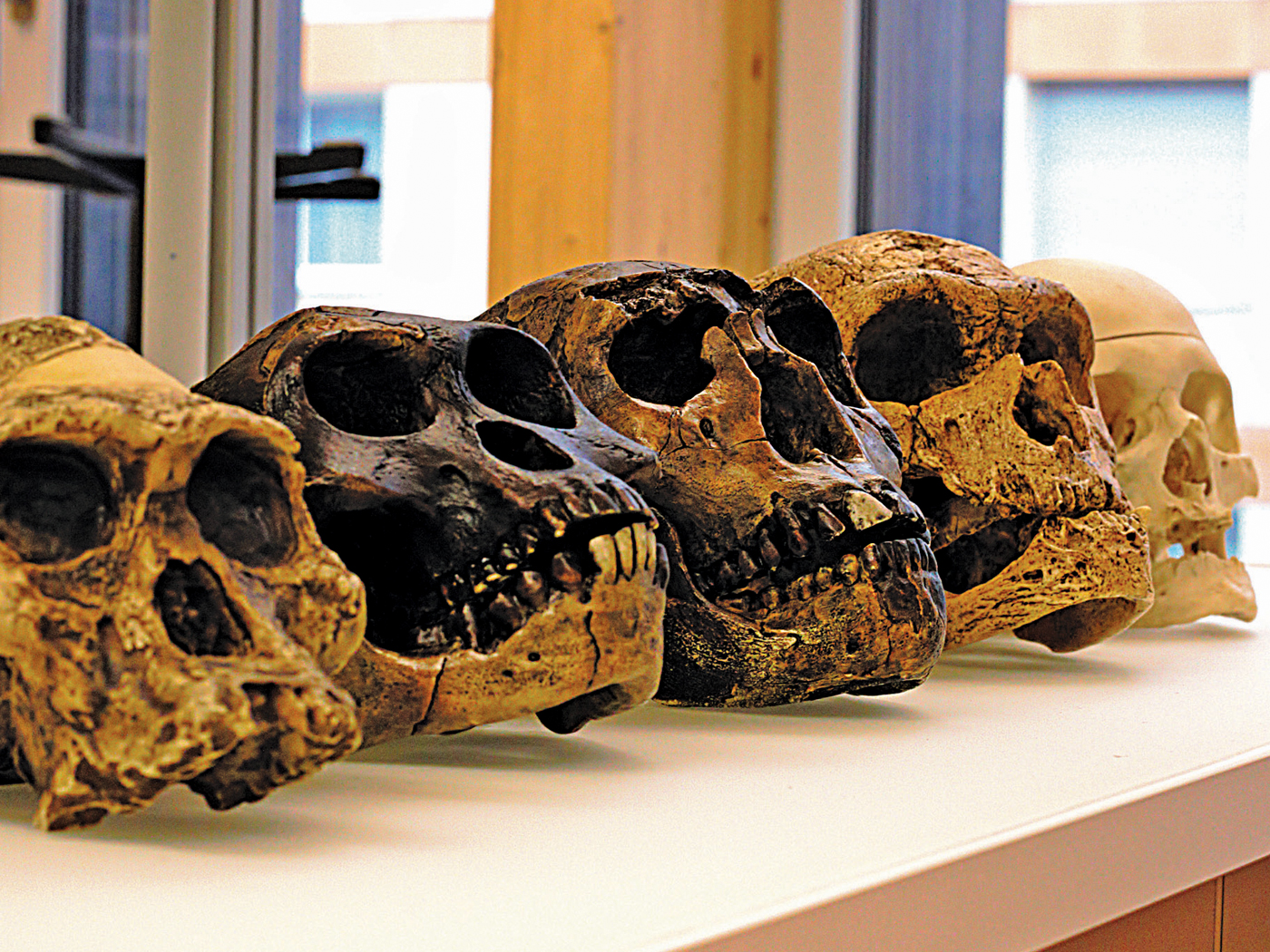"The exact contrary of what is generally believed is often the truth."
—Jean de la Bruyere (17th century)
Even though the large majority of modern scientists still embrace an evolutionary view of origins, there is a significant and growing number of scientists who have abandoned evolution altogether and have accepted creation instead.1 This phenomenon of recent times has occurred not only because many scientists recognize the dearth of evidence from paleontology, biology, and other fields to support evolution, but also due to the realization that the world around us is incredibly complex and shows so many signs of design that it cries out for an Intelligent Designer. Man shares with animals the ability to integrate sensory information and to direct motor responses through a command center called the brain. In higher vertebrates, the brain has the ability to learn, and, in the case of humans, to think. The very fact that man possesses the capacity to even think about thinking sets him further apart from animals. So, too, does his brain's incredibly complex structure, which makes thinking possible.
The adult brain—weighing only about three pounds and averaging about 1400 cubic centimeters—contains about ten billion (1010) neurons. The neuron (or nerve cell) is the basic unit of the brain. Each contains branching fibers, called dendrites, and each neuron is in dendritic contact with as many as 10,000 other neurons. Amazingly, the total number of neuron interconnections (also called "bits") is approximately 1000 trillion (1015), and if the dendritic connections were laid end to end, they would circle the earth more than four times.
To put this in another perspective, one could compare the human brain to the most sophisticated of computers—the supercomputer. The Cray-2 Supercomputer has a speed of 109 computations per second. More impressively, the brain's speed is perhaps 1015. Furthermore, the Cray-2 has a storage capacity of 1011 bits, as compared to 1014 bits in the brain, making the brain equivalent to 1,000 supercomputers.2 Oxford Professor Roger Penrose, evolutionist and author of the 1989 book, The Emperor's New Mind, cautions, however, against stating that the human brain is just a complex computer or that a computer will ever be able to think (i.e., artificial intelligence): "The very fact that the mind leads us to truths that are not computable convinces me that a computer can never duplicate the mind."3 The brain's sophistication has also prompted prolific science writer (and evolutionist) Isaac Asimov to acknowledge that "in Man is a three-pound brain which, as far as we know, is the most complex and orderly arrangement of matter in the universe."4 In his iconoclastic volume, Evolution: A Theory in Crisis, evolutionist Michael Denton has offered the following descriptive observation and analogy regarding the brain's 1015 connections:
Numbers in the order of 1015 are of course completely beyond comprehension. Imagine an area about half the size of the USA (one million square miles) covered in a forest of trees containing ten thousand trees per square mile. If each tree contained ten thousand leaves, the total number of leaves in the forest would be 1015, equivalent to the number of connections in the human brain.5
Although Dr. Denton is not a creationist, he argues a good case against the random chance (mindless) processes of evolution bringing about higher forms of life and a correspondingly complex brain, noting that the human brain contains a "forest of fibers [which] is not a chaotic random tangle but a highly organized network . . . [with] communication channels following their own specially ordained pathways through the brain"6 (emphasis ours). Denton also concludes that it "would take an eternity" for engineers to assemble an object remotely resembling the brain, using the most sophisticated engineering techniques.7 Not only does the incredible design of the brain point to a Master Designer, but so, too, does the Law of Cause and Effect. Simply put, this law states that every phenomenon is an effect of a cause, and that no effect can be measurably greater than its cause. Therefore, using causal reasoning, the first cause of intelligence must be of supreme intelligence.
How, then, does the evolutionist explain the origin and function of the brain? Darwin, himself, conceded in Origin of Species that the formation of the eye—a part of the nervous system over which the brain is in charge—by natural selection "seems, I freely confess, absurd in the highest degree."8 Yet he claimed that it must have happened anyway. In addition, evolutionary writer Lewis Thomas candidly admits regarding the brain's operation: "We know a lot about the structure and function of the cells and fibers of the human brain, but we haven't the ghost of an idea about how this extraordinary organ works to produce awareness."9
Many evolutionists either avoid the question altogether—Nobel laureate and evolutionist John Eccles declared it to be "extraordinary that there has been so little publication on the brain's development during the most important creative process of biological evolution"10—or offer bizarre theories.11 But recently, some evolutionists have seriously endeavored to suggest possible mechanisms that could have produced something as complex as the brain, but their theories, frankly, perhaps only reveal that many evolutionary scientists are more right-brain (creative) than left-brain (cogitative) inclined. For example, in his recent book, Evolution of the Human Brain (1989), Eccles wrote that "while recognizing that much is unknown or only imperfectly known, I have been able to unfold the fascinating story of hominid evolution of the human brain using creative imagination restrained by rational criticism"12 (emphasis ours).
At any rate, the most common mechanisms cited are natural selection and mutations. In Richard Dawkins' lucidly written, The Blind Watchmaker, he attempts to counter the oft-used creationist argument that just as a watch is too complicated and purposeful to have come about by accident, so, too, are living things—especially humans. Dawkins maintains that "natural selection, the blind, unconscious, automatic process, which Darwin discovered,13 is the mechanism that has brought about higher forms of life, and, by implication, the highest manifestation of life's complexity: the human brain." This is pure speculation, of course, on Dawkins' part. No scientist has ever observed natural selection (also known as "survival of the fittest") bringing about a new trait or animal.
Another evolutionist, Carl Sagan, has tackled the brain's origin with lyrical (and very creative) writing in The Dragons of Eden.14 Sagan's subtitle reveals the non-scientific nature of his study: "Speculations on the Evolution of Human Intelligence" (emphasis ours). Sagan declares that mutations—mistakes in the genetic makeup of a molecule—are the raw materials of evolutionary development.15
Genes, however, are very stable; they rarely change. Furthermore mutations, when they occur, are usually lethal and almost always harmfu1.16 The evolution of just one species into another would require hundreds (thousands? millions?) of accumulated beneficial mutations. Clearly the human brain could not be conceived as having been formed by such "mistakes." Mindless evolution could never, even in a trillion years, produce the human brain. In fact, it is so overly complex that most of it remains unused, yet another conundrum for evolutionists.
It must be acknowledged that one cannot prove, scientifically, that the animal or human brain was created by a Supreme Intelligence. The question of origins—creation or evolution—is almost entirely outside the experimental domain of science, for whenever the first brain was formed, there were no human observers. Cognitively, however, and from observation, it is reasonable to conclude that the human brain was created, it certainly requires more faith to believe the brain was formed by mindless evolution than it does to believe it was created. It was the Apostle Paul who declared the obvious: "For the invisible things of Him from the creation of the world are clearly seen" (Romans 1:20).
The question of origins is of supreme importance even though ultimately it is outside the domain of experimental science. As we seek our identity in a vast universe, what we believe about origins will influence how we think and how we view our destiny. If we choose to believe that we are the product of chance, random processes (evolution), where man is perhaps merely of the highest order, then we will possess a materialistic and relativistic philosophy. On the other hand, if we choose to believe that our brain was created by a Master Intelligence, then we will have a theological world view, one which should prompt us to use our minds to understand His purpose for His creation. This was, after all, the conclusion of no less than Isaac Newton, a creationist, and, arguably, the greatest of all scientists, who declared that we had been created "to think God's thoughts after Him."
[1] By evolution, we mean "macroevolution," i.e., molecules-to-man evolution; we do not mean microevolution (variation, adaptation, which is not "vertical" in direction).
[2] Donald B. DeYoung and Richard B. Bliss. "Thinking About the Brain," Acts & Facts Impact No. 200 (El Cajon, California: Institute for Creation Research, February 1990), p. ii.
[3] "Those Computers Are Dummies", Time Vol. 135, No. 26, June 25, 1990, pp. 74-75.
[4] Isaac Asimov, "In the Game of Energy and Thermodynamics You Can't Even Break Even," Smithsonian 1 (August), p. 10.
[5] Michael Denton, Evolution: A Theory in Crisis (London: Burnett Books, Ltd., 1985), p. 330.
[6] Ibid.
[7] Ibid., p. 331.
[8] Charles Darwin, Origin of Species (New York: Avenel Books, 1979), p. 217.
[9] Lewis Thomas, "On Science and Uncertainty," Discover (October 1980) p. 59.
[10] John C. Eccles, Evolution of the Human Brain: Creation of the Self (London: Routledge, 1989), p. xi.
[11] DeYoung and Bliss, "Thinking About the Brain," p. iii.
[12] Eccles, Evolution of the Human Brain, p. xi.
[13] Richard Dawkins, The Blind Watchmaker (New York: W.W. Norton & Company, 1987), p. 5.
[14] Carl Sagan, The Dragons of Eden: Speculations on the Evolution of Human Intelligence (New York: Ballantine Books, 1977).
[15] Ibid., p. 27.
[16] Regarding the proposed evolutionary mechanisms of mutations and natural selection, evolutionist Jeffrey Wicken has written: "As a generative principle, providing the raw material for natural selection, random mutation is inadequate, both in scope and theoretical grounding." ("The Generation of Complexity in Evolution: A Thermodynamic and Information-Theoretical Discussion." Journal of Theoretical Biology, Vol. 77 (April 1979). p. 349).
* Mark Looy coordinates ICR's "Back to Genesis" seminars and hosts the ICR radio broadcast, "Science, Scripture, and Salvation." He holds an M.A. in history from San Diego State University, and is currently working on his doctorate in education.


















